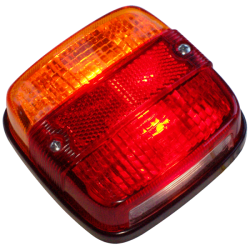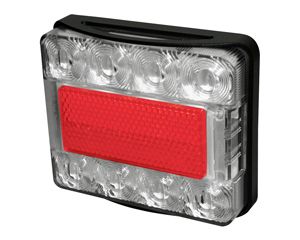Trailer Lights
Most trailers get a bit of a hard life, they get knocked around, overloaded, left outside to the elements, are normally poorly maintained, and are expected to perform and be ready to work at a moments notice.
Trailers are usually built pretty rugged and can handle these expectations and types of abuse, but they do have an Achilles heel – the lights!
Lights are a critical component on the trailer, they let other people on the road know that you are towing a trailer and of your intentions, whether braking, or turning. Failure to have working or adequate lights on your trailer can and does cause or contribute to road accidents. According to the NZ Transport Agency, inadequate or faulty vehicle lighting kills 7 people and injures 88 every year.
Lights being delicate in both nature and construction are subjected to more severe conditions and applications on trailers than almost any other vehicle on the road. Day to day knocks, bumpy roads, basic suspension, reversing damage, vibration, dirt, dust and water take their toll on your lights and fitting the right lights to your trailer can assist in ensuring your lights work when you need them.
Incandescent Bulb or LED?

Incandescent bulb lights have been used on trailers since the early days of motoring and are still in use on the majority of trailers in this country. They are cheap and easy to maintain and replacement parts are readily available. One of the reasons for their popularity is that If any part of the light is damaged, you can buy and fit a new lens or bulb from almost any auto supply shop, and be back on the road in minutes.
However, having a bulb as its light source is one of its downfalls when comparing them against LED lights. The filament within the bulb does a pretty good job of standing up to the road vibration and bumps that a trailer will give it, but eventually the filament will stretch, weaken and fail. Incandescent light units are normally only water resistant and over time, water can ingress through the seals and into the light unit and corrode the bulb fittings and connectors.
Compared to LEDs, incandescent bulbs do not shine as bright or as fast. It takes a few milliseconds for the bulb filament to heat up and glow where LEDs light up intensely and almost instantly.
LED lights use small diodes which emit a bright light when an electrical current is applied. Diodes are set in an array and the more diodes you have, the brighter the light will be. Diodes are a solid state unit that do not have any mechanical parts like filaments or connectors to fail, but diodes can prematurely burn out, and if one diode fails within the array, there are normally plenty left to back it up. LEDs are shock and vibration proof.
LEDs are available to operate (without any reduction in light intensity) within a wider voltage range between 9 and 28 volts compared to the incandescent bulb which has a fixed voltage of either 12 or 24 volt. LEDs also consume around 1/10th of the power of an incandescent bulb which allows more power to be delivered to your trailer brakes (electric) under braking.
By far the biggest advantage of LED lights is their longevity and most manufacturers claim they will last 100,000 hours, which is reportedly six times longer than an incandescent bulb.
The majority of trailer LED lights are waterproof and submersible, which makes them perfect for boat trailers and trailers living in wet environments. LED are normally sealed within its light and its circuitry covered in a water proof epoxy resin with just the cable and depending on the model, mounting screws protruding through. Check the waterproofing and warranty for wet use before purchasing submersible LEDs.
LEDs have up until recently, been quite expensive items to purchase, but with increasing numbers of manufacturers supplying LEDS and manufacturing costs coming down, they are quickly becoming comparable in price to incandescent lights.

One disadvantage of LED lights, is that if the light gets damaged or fails, the whole unit normally requires replacing. With the increasing and rapid supply of LED lights on the market, your original light could be quickly superseded and an identical replacement difficult to find. If you are not happy with mis-matched lights, then you will have to fork out for a whole new set.
European vehicles & Trailers with LEDs
If you own a late model European vehicle (BMW, Mercedes, Audi, VW, Land Rover Discovery & Range Rover, Porsche) with a factory fitted towbar or have a genuine towbar package fitted, you many find you have a few problems when hooking up a trailer fitted with LED lights.
When the trailer is attached to the tow vehicle, the vehicles on-board computers “lamp out” sensor may get false computer errors due to the small amount of power used by the LEDs. The computer may or may not recognise the LEDs and if not will result in warning lights flashing on the dashboard (lamp out) and cause the LEDs to either not light up at all or rapidly flash on and off.
To overcome this problem, an additional wiring adaptor or interface needs to be fitted to bypass the “lamp out” sensor. Most major trailer parts suppliers or auto electricians will be able to provide you with the correct adaptor for your vehicle and trailer.
As more European trailers are fitted with LED lights, the vehicle manufacturers will be sure to remedy the problem, but until they do, its either incandescent lights or fitting an adaptor for your trailer.
Trailer Light Lenses
Trailer lights are exposed to the elements probably more so than any other vehicle and lights being the most delicate part of the trailer tend to bear the brunt of this. Vibration, rocks and road stone, dust, rain and sun all take their toll on lights over time and depending on the end use of your trailer, buying the right type of lens can increase the lights life span.
Trailer light lenses come in both acrylic and polycarbonate and there are some significant differences between them.
Polycarbonate is a popular choice for light lenses as they are almost impossible to break. They are very strong and have a high resistance to impact from stones or objects. Protective glasses and car headlights are normally made from polycarbonate because of this reason.
Acrylic although strong, does not have the same impact resistance as polycarbonate and will, if hit hard enough, shatter. Some manufacturers use a high impact acrylic formula for their lights and this increases the lights resistance to most impacts.
Acrylic lenses have an excellent resistance to scratching and damage from abrasion. One of polycarbonates weaknesses is its natural tendency to scratch easily. There are special manufacturer applied coatings that can increase the resistance to scratches and abrasion and you will normally pay more for coated lenses.
Acrylic does have excellent resistance to UV damage. Coloured lenses will not fade and clear lenses will not yellow or craze (Micro cracks on the surface) like polycarbonate lenses will, and this makes acrylic lenses ideal for trailers that are exposed to high levels of sunlight. There are again, manufacturer supplied UV coatings that can be applied to polycarbonate lenses to prevent fading and yellowing.
Lastly, acrylic has good chemical resistance. Some polycarbonates can glaze over even when washed using a strong detergent or when exposed to petrochemicals (petrol, oil, solvents). If you have or fit polycarbonate lens lights to your trailer, wash them only with water and a mild detergent.